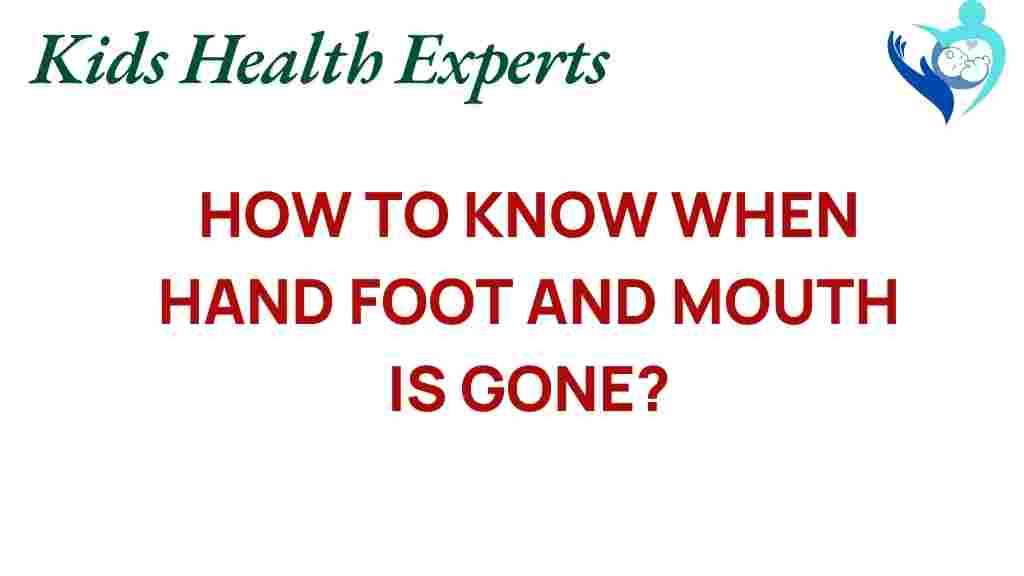How to Identify When Hand, Foot, and Mouth Disease Has Resolved
Hand, foot, and mouth disease (HFMD) is a common viral infection, particularly affecting young children. Understanding the symptoms, recovery process, and contagious nature of this illness is crucial for parents and caregivers. In this article, we will explore how to determine when hand, foot, and mouth disease has resolved, and share essential health tips for managing this illness in children.
Understanding Hand, Foot, and Mouth Disease
Hand, foot, and mouth disease is primarily caused by coxsackievirus A16 and enterovirus 71. It is characterized by:
- Fever
- Oral sores
- Rashes on hands and feet
- General discomfort
HFMD is highly contagious, especially among children under five years old. The virus spreads through direct contact with an infected person’s bodily fluids, including saliva, mucus, or fluid from blisters.
Symptoms of Hand, Foot, and Mouth Disease
Recognizing the symptoms of hand, foot, and mouth disease is important for timely management. Common symptoms include:
- Fever (often the first sign)
- Sore throat
- Painful mouth sores
- Rash on hands and feet
- Loss of appetite
- Irritability in children
These symptoms can last anywhere from 7 to 10 days. However, the question remains: how do you know when the disease has resolved?
Signs of Recovery from Hand, Foot, and Mouth Disease
Identifying the point at which hand, foot, and mouth disease has resolved is vital for both the well-being of your child and preventing the spread of the virus. Here are some signs of recovery:
- Decreased Fever: A significant drop in fever is often the first sign of recovery.
- Improved Appetite: As the child begins to feel better, their appetite typically returns.
- Reduced Irritability: A noticeable decrease in fussiness or irritability indicates improvement.
- Healing of Sores: Mouth sores and rashes should begin to heal, with scabs forming and redness fading.
Once these signs are apparent, you can feel more confident that hand, foot, and mouth disease is resolving.
Contagious Period of Hand, Foot, and Mouth Disease
Understanding the contagious period is essential for effective illness management. Hand, foot, and mouth disease is contagious from the moment symptoms appear until all sores have healed and the child is fever-free for at least 24 hours. This period can last up to a week or more after the onset of symptoms.
To prevent spreading the infection, keep your child at home during this time and practice good hygiene, such as frequent hand washing.
Health Tips for Managing Hand, Foot, and Mouth Disease
Here are some health tips to help manage hand, foot, and mouth disease effectively:
- Stay Hydrated: Ensure your child drinks plenty of fluids to prevent dehydration, especially if they have mouth sores.
- Soft Foods: Offer soft, bland foods that are easy to swallow, minimizing discomfort from mouth sores.
- Over-the-Counter Pain Relief: Consult your pediatrician about using pain relief medications like acetaminophen or ibuprofen.
- Maintain Hygiene: Encourage frequent hand washing and avoid sharing utensils, towels, or other personal items.
Moreover, consider creating a comfortable environment where your child can rest and recover. Soft pillows, favorite toys, and a quiet space can significantly improve their comfort.
Step-by-Step Process to Monitor Recovery
To effectively monitor your child’s recovery from hand, foot, and mouth disease, follow these steps:
- Track Symptoms: Keep a daily log of your child’s symptoms, including fever, oral sores, and rashes.
- Observe Eating Habits: Note any changes in appetite and the ability to eat and drink without pain.
- Monitor Fever: Record the child’s temperature regularly to spot any fluctuations.
- Check for Healing: Observe mouth sores and rashes for signs of healing, such as reduced redness and scab formation.
By following this process, you can have a clearer picture of your child’s health status and know when it is safe to return to normal activities.
Troubleshooting Tips for Common Issues
Even as your child recovers from hand, foot, and mouth disease, some issues may arise. Here are troubleshooting tips for common concerns:
- Persistent Fever: If the fever lasts longer than three days, consult your pediatrician.
- Severe Pain: If your child is experiencing intense pain from mouth sores, discuss pain management options with your healthcare provider.
- Dehydration Signs: Watch for signs of dehydration, such as dry mouth or lack of urine output. If these occur, seek medical attention.
- Secondary Infections: If rashes worsen or new symptoms appear, contact your pediatrician for evaluation.
Staying proactive in managing your child’s health during this time will help ensure a smooth recovery process.
Conclusion
Hand, foot, and mouth disease can be a challenging experience for both children and parents. By understanding the symptoms, recovery signs, and health tips mentioned above, you can effectively manage this illness in your child. Always remember that while HFMD is typically mild, monitoring your child’s condition and consulting with a healthcare professional when necessary is crucial for their health and well-being.
For more information on pediatric health, you may visit CDC’s Hand, Foot, and Mouth Disease Page.
In addition, for caregiving tips and resources, check out this helpful guide on child care.
This article is in the category Conditions and created by KidsHealthExperts Team
